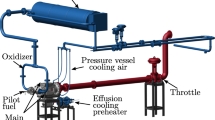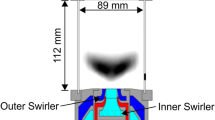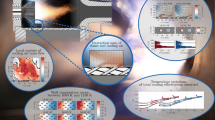Abstract—
The problem of reducing the amount of harmful emissions during the operation of gas turbine units (GTUs) has become especially important in recent years. In this regard, for optimizing the flow thermal and gas dynamic processes, the flow velocity and the combustion process in the GTU combustion chambers have to be studied in detail. Such optimization makes it possible not only to secure highly complete fuel combustion and stable operation of the burners in a wide range of the fuel to oxidizer ratios but also to decrease the amount of harmful emissions. The article deals with studying the temperature field structure of the pilot flame produced by a model gas turbine two-zone burner. The instantaneous temperature distribution in the flame was recorded using the method based on thermally-assisted planar laser-induced fluorescence (PLIF) in exciting the Q1(8) transition band (1–0) of the A2Σ+–X2Π OH hydroxyl radical electron system. The study was carried out for the case of combusting a partially mixed methane and air mixture with a significant Air-fuel ratio α = 1.54 under standard conditions in swirl flow at the Reynolds number Re = 1.5 × 104. The procedure of calibrating a thermally assisted PLIF system with using a thermocouple is described in detail. The article also presents instantaneous temperature distribution patterns downstream of the flame front in the range 1500–2000 K. The obtained data show that the temperature field features a significant heterogeneity due to the flame being stabilized at the central fuel flame periphery by a swirl mixing air flow. The conditional averaging of the temperature field with taking into account the alternation caused by the flame’s front motion testifies that the temperature at the front base is close to the minimal adiabatic temperature values of the premixed mixture near the “lean” (α > 1, i.e., when the amount of oxidizer (air) is larger than that necessary for complete fuel combustion) flammability limit.







Similar content being viewed by others
Notes
CMOS is a metal–oxide-semiconductor complementary structure.
REFERENCES
O. Lucco-Negro and T. O’Doherty, “Vortex breakdown: A review,” Prog. Energy Combust. Sci. 27, 431–481 (2001). https://doi.org/10.1016/S0360-1285(00)00022-8
N. Syred, “A review of oscillation mechanisms and the role of the precessing vortex core (PVC) in swirl combustion systems,” Prog. Energy Combust. Sci. 32, 93–161 (2006). https://doi.org/10.1016/j.pecs.2005.10.002
T. Lieuwen, H. Torres, C. Johnson, and B. T. Zinn, “A mechanism of combustion instability in lean premixed gas turbine combustors,” J. Eng. Gas Turbines Power 123, 182–189 (2000).
W. Meier, P. Weigand, X. R. Duan, and R. Giezendanner-Thoben, “Detailed characterization of the dynamics of thermoacoustic pulsations in a lean premixed swirl flame,” Combust. Flame 150, 2–26 (2007). https://doi.org/10.1016/j.combustflame.2007.04.002
E. Fooladgar, P. Tóth, and C. Duwig, “Characterization of flameless combustion in a model gas turbine combustor using a novel post-processing tool,” Combust. Flame 204, 356–367 (2019). https://doi.org/10.1016/j.combustflame.2019.03.015
X. Liu, A. M. Elbaz, C. Gong, X. S. Bai, H. T. Zheng, and W. L. Roberts, “Effect of burner geometry on swirl stabilized methane/air flames: A joint LES/OH-PLIF/PIV study,” Fuel 207, 533–546 (2017). https://doi.org/10.1016/j.fuel.2017.06.092
E. V. Palkin, M. Yu. Hrebtov, D. A. Slastnaya, R. I. Mullyadzhanov, L. Vervisch, D. K. Sharaborin, A. S. Lobasov, and V. M. Dulin, “Influence of a central jet on isothermal and reacting swirling flow in a model combustion chamber,” Energies 15, 1615 (2022). https://doi.org/10.3390/en15051615
A. C. Eckbreth, “Laser diagnostics for temperature and species in unsteady combustion,” in Unsteady Combustion, Ed. by F. Culick, M. V. Heitor, and J. H. Whitelaw (Springer, Dordrecht, 1996), pp. 393–410.
L. M. Chikishev, D. K. Sharaborin, A. S. Lobasov, A. A. Dekterev, R. V. Tolstoguzov, V. M. Dulin, and D. M. Markovich, “LES simulation of a model gas-turbine lean combustor: impact of coherent flow structures on the temperature field and concentration of CO and NO,” Energies 15, 4362 (2022). https://doi.org/10.3390/en15124362
T. Jaravel, E. Riber, B. Cuenot, and G. Bulat, “Large eddy simulation of an industrial gas turbine combustor using reduced chemistry with accurate pollutant prediction,” Proc. Combust. Inst. 36, 3817–3825 (2017). https://doi.org/10.1016/j.proci.2016.07.027
A. C. Benim, S. Iqbal, W. Meier, F. Joos, and A. Wiedermann, “Numerical investigation of turbulent swirling flames with validation in a gas turbine model combustor,” Appl. Therm. Eng. 110, 202–212 (2017). https://doi.org/10.1016/j.applthermaleng.2016.08.143
R. Giezendanner-Thoben, U. Meier, W. Meier, and M. Aigner, “Phase-locked temperature measurements by two-line OH PLIF thermometry of a self-excited combustion instability in a gas turbine model combustor,” Flow, Turbulence Combust. 75, 317–333 (2005). https://doi.org/10.1007/s10494-005-8587-0
C. Copeland, J. Friedman, and M. Renksizbulut, “Planar temperature imaging using thermally assisted laser induced fluorescence of OH in a methane–air flame,” Exp. Therm. Fluid Sci. 31, 221–236 (2007). https://doi.org/10.1016/j.expthermflusci.2006.04.005
V. Dulin, D. Sharaborin, R. Tolstoguzov, A. Lobasov, L. Chikishev, D. Markovich, S. Wang, C. Fu, X. Liu, Y. Li, and Y. Gao, “Assessment of single-shot temperature measurements by thermallyassisted OH PLIF using excitation in the A2Σ+–X2Π (1–0) band,” Proc. Combust. Inst. 38, 1877–1883 (2021). https://doi.org/10.1016/j.proci.2020.07.025
D. K. Sharaborin, A. G. Savitskii, G. Y. Bakharev, A. S. Lobasov, L. M. Chikishev, and V. M. Dulin, “PIV/PLIF investigation of unsteady turbulent flow and mixing behind a model gas turbine combustor,” Exp. Fluids 62, 96 (2021). https://doi.org/10.1007/s00348-021-03181-z
Funding
This study was financially supported by the Russian Science Foundation (grant no. 19-79-30075). The equipment was provided within the framework of the state contract with the Institute of Thermal Physics, Siberian Branch, Russian Academy of Sciences.
Author information
Authors and Affiliations
Corresponding author
Ethics declarations
The authors declare that they have no conflicts of interest.
Additional information
Translated by V. Filatov
Rights and permissions
About this article
Cite this article
Savitskii, A.G., Sharaborin, D.K., Dulin, V.M. et al. A LIF Study of the Temperature Field behind the Pilot Flame Front of a Gas Turbine Type Model Combustor. Therm. Eng. 70, 354–361 (2023). https://doi.org/10.1134/S0040601523050051
Received:
Revised:
Accepted:
Published:
Issue Date:
DOI: https://doi.org/10.1134/S0040601523050051




